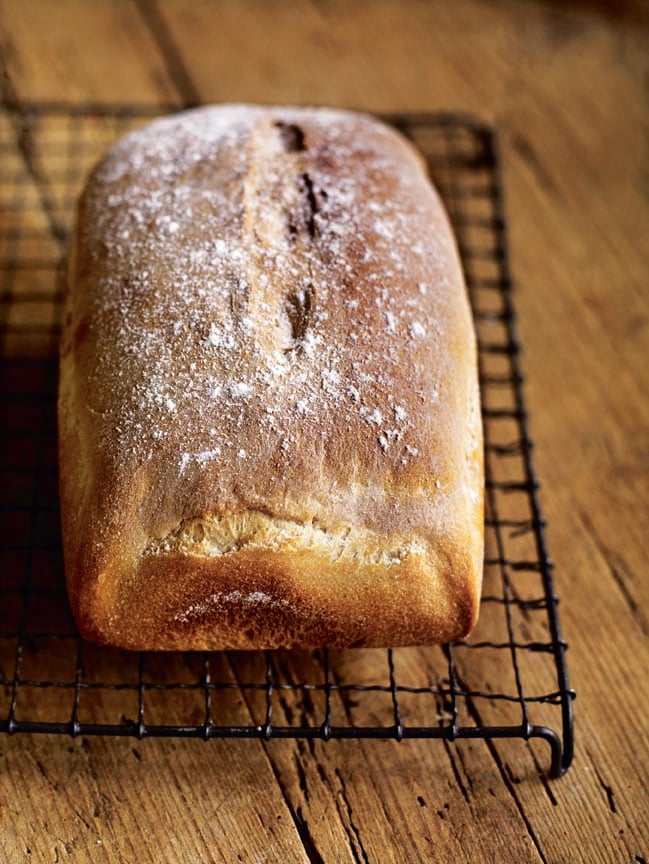
Rustic white loaf
- Published: 31 Dec 13
- Updated: 18 Mar 24
This delicious rustic loaf, from a Long Crichel Bakery recipe, can be made with either white or brown flour.

-
1 large loaf (about 16 slices)
-
Hands-on time 25 min, proving time 1 hour 45 min, oven time 35-40 min.
Ingredients
- 500g strong plain flour (ideally organic), plus extra for dusting
- 1 tsp salt (see tips)
- 20g fresh yeast (see Know-how)
- 325ml tepid water (about 30°C)
- Flavourless oil for greasing
Method
- Mix the flour and salt together in a mixing bowl. Finely crumble in the yeast, then add the tepid water and mix using your hands or a wooden spoon to bring together into a round, shaggy mass. Dig down to the bottom of the bowl to make sure there’s no dry flour left. Scrape off the excess dough from your hands or the spoon, cover the bowl with a clean tea towel and leave for 10 minutes.
- Rub a little oil over a 30cm x 30cm area of the work surface and a little more over your hands. Ease the dough gently out of the bowl onto the work surface, taking care not to pull or tear the mixture. Grab the edge of the dough furthest from you with one hand and pull it to meet the edge of the dough nearest to you. With the heel of the other hand, push down lightly on the top of the dough, and push it gently away from you – a movement of about 10cm (don’t pound or tear the dough – see tips), then give the dough a quarter turn.
- Complete this ‘fold, stretch and turn’ process no more than 10 times. Return the dough to the bowl and leave to rest for 10 minutes.
- Repeat this whole procedure again and leave to rest for another 10 minutes, then repeat once more and leave to rest for 30 minutes. From the time it is mixed, the dough will be rising and developing its structure of air bubbles with increasingly thin walls of gluten. It will also lighten and will have lost its stickiness, becoming silky and elastic.
- Put the dough on a clean and very lightly floured work surface and mould gently into the desired shape. You can either make a freeform loaf, then put it onto a baking sheet lined with baking paper, or drop the dough into a lightly oiled 900g loaf tin. Cover loosely with cling film and leave somewhere warm to prove for 45 minutes until the dough has puffed up and stays indented when pressed gently with your finger. Don’t over-prove the loaf or it may collapse during baking (see tips).
- Preheat the oven to 200°C/fan 180°C/gas 6. Make a long shallow slash down the centre of the loaf with a scalpel, razor blade or very sharp knife to allow the loaf to open up during baking. Bake for 35-40 minutes until well coloured (see tips). Remove from the tin if necessary, transfer to a cooling rack and leave to cool before slicing.
- Recipe from January 2014 Issue
Nutrition
- Calories
- 107kcals
- Fat
- 0.4g (0.1g saturated)
- Protein
- 3.1g
- Carbohydrates
- 23.1g (1.3g sugars)
- Fibre
- 1.3g
- Salt
- 0.3g
delicious. tips
This dough doesn’t require fierce kneading – treat it gently. If you like your bread quite salty you can add a little more – but salt slows down the action of the yeast so the more you use, the longer you’ll need to leave the dough to rise. Keep an eye on your loaf as it proves. It should rise no more than double its size.
To make sure the loaf is cooked, pick it up (use a tea towel), turn it over and rap on the base. It should sound deep and resonant, as if it were hollow. You can also check the temperature inside the loaf with a digital thermometer – anywhere between 85°C and 100°C is good. It’s hard to resist, but don’t crack into the bread before it has cooled a while – you’ll spoil the texture.Freeze the cooked, cooled loaf, well wrapped, for up to 3 months. Defrost before serving, or slice before freezing.
Fresh yeast comes in a rubbery, creamy coloured, crumbly block. You can sometimes get it from health food shops and in-store bakeries in large supermarkets- you need to ask. It will keep in the fridge for up to 2 weeks. You can use easy blend or fast-action yeast instead, but use about half as much- a 7g sachet would be enough for this recipe.
Buy ingredients online
Rate & review
Rate
Reviews
Subscribe to our magazine
Food stories, skills and tested recipes, straight to your door... Enjoy 5 issues for just £5 with our special introductory offer.
Subscribe
Unleash your inner chef
Looking for inspiration? Receive the latest recipes with our newsletter
